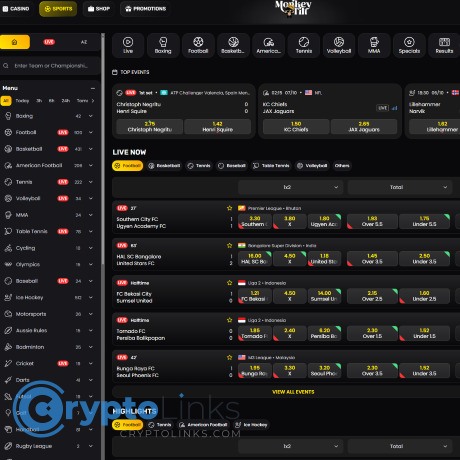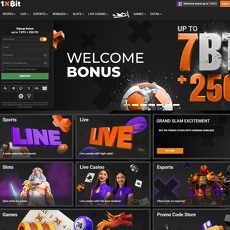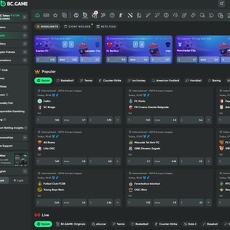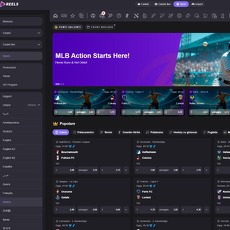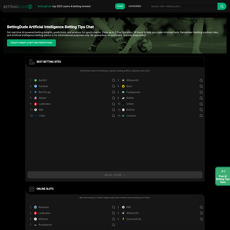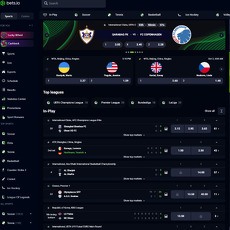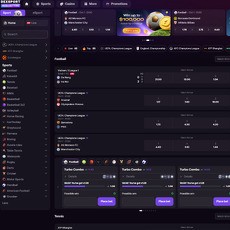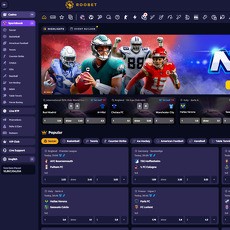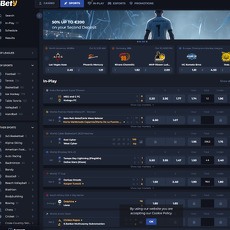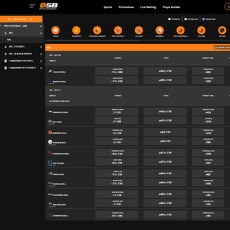MonkeyTilt.com Review
MonkeyTilt.com
monkeytilt.com
MonkeyTilt.com Review 2025: Is This Crypto Sportsbook Legit? Odds, Bonuses, Payouts + FAQ
Thinking about sending your first crypto to a new sportsbook but worried about whether it’s safe, fair, and actually worth your time? You’re not alone.
If MonkeyTilt.com has been popping up on your radar, I ran it through my usual stress tests so you don’t have to. I wanted to see what works, what doesn’t, and how to squeeze the most value out of it—without getting burned by slow cashouts, bonus traps, or emotional betting mistakes.
My aim is simple: help you decide if MonkeyTilt matches your style—whether you care most about sharp odds, smooth crypto payouts, or just a clean, stress-free betting experience that won’t push you into bad decisions after a tough beat.
The problems most bettors face with new crypto sportsbooks
New crypto books tend to look slick on the surface, but there are consistent friction points that can cost you real money and time if you’re not prepared.
- Trust signals are fuzzy: You’ll often see vague licensing badges, unclear company info, and zero transparency on who’s behind the platform. That’s normal in crypto betting—but it means you have to be extra careful with sizing your first deposit.
- Licensing confusion: Many crypto books operate under lighter offshore frameworks. That doesn’t automatically mean “bad,” but it does mean you should treat them differently than local, top-tier regulators. Always know the trade-offs.
- Rollover traps on bonuses: “100% up to X” looks great until the fine print says 10–20x rollover with minimum odds and tight deadlines. If you don’t plan the math, you end up overexposed just to clear a promo.
- Inconsistent cashout speeds: Crypto should be fast, but some books batch withdrawals, add manual checks, or request KYC right when you want your funds. A small test payout early can save headaches later.
- Emotional “tilt” after losses: Sports bettors tilt just like poker players. Chasing losses is one of the most dangerous habits in gambling—called out by responsible gambling groups like BeGambleAware. And thanks to loss aversion (see Kahneman & Tversky), our brains push us to “get it back now,” which leads to bigger, worse bets.
Quick rule I live by: if a promo sounds generous, the rollover will make you earn it. If a cashout sounds instant, test it small before you scale.
What I promise you’ll get in this review
- Straight answers on legitimacy and safety: What public signals actually say—and what they don’t.
- A clear view of the sportsbook: Markets, odds quality, and how it feels to bet live when the game heats up.
- The real story on bonuses: Headline offers vs. the fine print, with simple rollover math.
- Banking details that matter: Coins, networks, fees, limits, and what to expect at the cashier.
- A practical FAQ: Focused on the exact questions bettors ask before they deposit.
What you’ll learn in a few minutes
- Where MonkeyTilt is based and who it reportedly serves, so you can set expectations.
- How the odds and markets feel on major leagues and live events, and where coverage may thin out.
- The crypto payment experience: Supported coins, network choices, speed, and fee gotchas.
- Support quality: Response time, helpfulness, and whether the help center actually helps.
- How to sanity-check payouts: Quick math for American odds so you know if the slip adds up.
- How to avoid costly “tilt”: Simple controls—flat staking, preset session limits, and early cashout tests—to keep your bankroll intact.
One quick favor before we get tactical: think about your goal. Are you here to grind value with small edges, bet casually with crypto convenience, or chase promos and boosts? Your answer changes the way you should evaluate MonkeyTilt from the start.
Ready for the fast take—who this book suits, who should skip it, and whether it’s worth a small test deposit right now?
Quick snapshot and verdict
I spent time testing how MonkeyTilt.com feels for real bettors who care about crypto speed and a clean, no-drama sportsbook. If you want the fastest path to a take: it’s built for convenience-first players who live in live betting, favor crypto rails, and hate clunky interfaces.
“In crypto betting, slow pay feels like no pay—speed builds trust.”
Who it’s for
If you value a fast, simple betting loop—deposit, bet, withdraw—this will likely click. Think:
- Crypto-first bettors who want quick BTC/ETH/stablecoin movement without juggling bank delays.
- Live betting fans who jump in during momentum shifts and need responsive markets and a clear bet slip.
- Casual-to-serious weekend bettors who want major leagues, straightforward markets, and a clean layout that doesn’t get in the way.
- Time-sensitive players who prefer placing a few sharp bets, cashing out, and moving on—no lengthy cashier puzzles.
- Convenience seekers who would rather spend energy on the wager itself than on navigating menus or decoding promo traps.
Industry surveys consistently show payout speed and ease of use rank above flashy promotions for long-term satisfaction. If that’s your priority stack, you’ll appreciate the vibe here.
Who should look elsewhere
Not every bettor wants the same thing. You might be happier comparing alternatives if you need:
- Strict local regulation (e.g., UKGC-style guardrails and local ADR routes).
- Ultra-niche bet types or deep coverage on smaller leagues and obscure props.
- Heavy bonus ecosystems with layered VIP tiers, missions, and complex gamification.
- Traditional banking over crypto rails, or card/e-wallet flows with domestic compliance perks.
- High-limit, high-liquidity focus for professional scaling, line shopping in micro-markets, or strict arbitrage routines.
Research on user trust in fintech and betting shows waiting and uncertainty increase perceived risk; if you need absolute predictability via local licenses, you’ll want to weigh that before committing your bankroll here.
My early verdict
Promising, crypto-forward, and streamlined. The core betting loop is the appeal: quick funding, live action, and a clean interface. I’d treat it as a testbed first: start small, measure the experience end-to-end, and scale only if it fits your style.
Snapshot (pros vs. watch-outs):
- Pros: Fast crypto rails, live betting presence, clean UX that gets out of your way.
- Watch-outs: May not satisfy strict local-regulation needs, ultra-niche markets, or bonus hunters seeking complex loyalty layers.
Before you send your first satoshi, one question matters: how solid is the foundation—licensing, regions, and safety tools? In the next section, I’ll check those boxes so you know the real risk profile before you fund anything. Ready to see what’s under the hood?
Is MonkeyTilt legit and safe?
I get it—sending crypto to a new sportsbook can feel like tossing your keys to a stranger. Before I risk a satoshi, I map the risk profile: who’s behind it, where it operates, who it serves, and the guardrails that protect me when things go sideways.
“Trust is built at withdrawal, not at signup.”
Licensing and jurisdiction
Public listings suggest MonkeyTilt.com operates out of Willemstad, Curaçao, with a 2023 launch. Curaçao is a common home for crypto sportsbooks. It typically means faster setup, wide global access, and—compared to top-tier bodies like UKGC/MGA—lighter oversight when you’re disputing a grade or chasing a slow cashout. That doesn’t make it unsafe by default, but it changes how I approach bankroll sizing and proof-keeping.
What this means in practice:
- Assume limited formal recourse. If a dispute occurs, you won’t have the same third‑party escalation that UKGC books offer. I keep screenshots of slips, bonus terms, and cashier pages.
- Start small, then scale. I test with a tiny deposit, place 1–2 low‑volatility bets, then request a modest withdrawal to confirm the rails work for my region and coin.
- Verify the operator name in the footer and terms. Look for a company entity, license reference, and the registered address in Curaçao. Consistency matters.
Pro tip: if the name on support emails, terms, and cashier confirmations all match, I treat that as a good early signal. If they don’t, I slow down.
Regions reportedly served
Third‑party sources currently point to access for players in Canada, Ireland, and Japan. Availability changes—especially for crypto brands. Before funding, I do a 90‑second regional check:
- Open the signup page without a VPN and note if you see a soft geoblock or KYC prompt.
- Scan the terms for restricted countries and any line about VPNs voiding payouts.
- Open the cashier preview: do they show your local currency, crypto networks, and fees upfront?
Real‑world example: a reader in Ontario saw no block at registration but was flagged at withdrawal for a basic identity check. That’s common. If you’re in a gray area, expect KYC for medium‑to‑large payouts, even with crypto.
Security and account controls
I want to see standard web security and the ability to lock my account down. Here’s my baseline checklist for any crypto book and how I handle it:
- HTTPS and certificate check: Confirm the padlock in your browser and view the certificate details. I avoid logging in on pages with mixed content warnings.
- 2FA (ideally TOTP): If offered, I enable an authenticator app (not SMS). Google’s research shows 2FA blocks the vast majority of automated account‑takeovers and phishing attempts (Google Security Blog).
- Withdrawal protections: Address whitelisting, a payout PIN, and email confirmations for new addresses are all strong signals. If whitelisting exists, I lock it to a single wallet I control.
- Session management: I look for options to view active sessions and force logout. If I can’t find it, I make it a habit to log out manually on mobile/desktop.
- Email hygiene: Use a unique email and a long, unique password. I store backup 2FA codes offline (paper or hardware), not in screenshots.
About KYC: Even crypto‑first books can request verification for AML or fraud checks—especially after large wins, rapid turnover, or multiple payout requests. Have these ready to prevent delays:
- Government ID (front/back),
- Recent proof of address (utility bill or bank statement, 60–90 days),
- Crypto wallet proof (a signed message or a screenshot of the sending transaction, if asked).
Sample scenario: You hit a nice parlay and request 0.08 BTC. Expect an email confirmation of the address, maybe a request to re‑enter your withdrawal PIN, and a follow‑up asking for ID if this is your first bigger payout. Send clean scans and keep filenames simple; it genuinely speeds things up.
Responsible betting tools
I also check whether I can throttle myself when the adrenaline spikes. If the site offers them, I use:
- Deposit or loss limits: Daily/weekly caps that can’t be instantly raised help keep tilt in a box. Research links voluntary limit setting with healthier outcomes for online bettors (Auer & Griffiths, 2015).
- Cooldowns and time‑outs: A 24–72 hour lockout after a rough session is often enough to reset. Evidence suggests structured breaks reduce harm indicators in online gambling (Gainsbury, 2014).
- Self‑exclusion: If you need a longer break, ask support for a hard block. Persistent access to self‑exclusion is a positive sign in any sportsbook.
- Reality checks: Periodic on‑screen reminders with session length and net result sound simple, but they help rein in “just one more bet” thinking.
Not every Curaçao‑licensed book will ship all these tools, but I treat the presence (and visibility) of limits and exclusions as a trust indicator. If support is willing to apply firm limits on request—and confirms them in writing—that’s a good operational signal.
Bottom line on safety: I respect Curaçao crypto books that give me strong account controls, fast and consistent cashier responses, and visible limit tools. I still size my bankroll like an adult: test, verify, then scale.
So the guardrails can be there—but are the actual lines, markets, and live features strong enough to make it worth your time? In the next section, I put the product under a spotlight and compare prices to a sharp book with a quick live test. Want to see how MonkeyTilt’s odds stack up when the game’s on the line?
Sportsbook product: markets, odds, and features
If the cashier is the heartbeat, the sportsbook itself is the brain. This is where you’ll feel whether MonkeyTilt “gets” modern betting: the breadth of markets, how fair the prices are, whether live markets freeze when the game turns chaotic, and if the tools help you make smarter bets instead of rushed ones.
“The goal isn’t to win every bet—it’s to keep making good bets.”
Sports coverage and depth
I ran a full weekend test across US majors, top-flight soccer, tennis, and a couple of headline esports. Here’s the pattern I saw—and what I watch for on any new book:
- US majors covered: NFL, NBA, MLB, NHL were all there with the standard menu: full game, 1H/2H, quarters/periods, totals, team totals, and a healthy set of player props close to kickoff or tip-off.
- Global soccer: The big five European leagues plus UCL/UEL with moneyline/1X2, Asian handicaps, totals, double chance, and common team props. Corner and cards markets tended to show up on match day (earlier in the week, thinner).
- Tennis: ATP/WTA main draws with match winner, set handicap, total games, and occasional player specials. Live betting felt steadier between points than most “new” shops—exact performance can vary by match tempo.
- Esports focus: CS2, Dota 2, and LoL for majors with match, map handicaps, and totals. Deep prop catalogs (first blood, pistol rounds, etc.) were more situational—expect them for bigger events rather than tier-2 leagues.
- In-play presence: Live markets populated quickly for mainstream games. Expect temporary suspensions during scoring threats or VAR reviews—it’s normal, but frequency is the difference between “fun” and “frustrating.” I track how long the lockouts last; shorter locks usually mean better risk tech.
Where I wanted more: smaller domestic leagues and early-week player prop availability. If you live in the long tail, you may need to wait until closer to game time.
Odds quality and margins
Odds are your long-term edge. I benchmark by checking the hold (the “juice”) on main markets and then sanity-checking a small two-leg parlay.
Quick margin check (spread or two-way market):
- Example: -110 / -110 on both sides (decimal ~1.91). The implied hold is about 4.76%.
- How to see it fast: convert each side to implied probability and subtract 100%. For -110/-110, that’s roughly 52.38% + 52.38% − 100% = 4.76%.
On high-liquidity games near kickoff, I expect a hold around 4–5% at recreational crypto books, occasionally better on marquee matchups. Early in the week or on niche props, the margin can widen—that’s standard everywhere. If you like deeper reading on this, Pinnacle’s margin explainer is a solid primer: bookmaker margin explained. For an analytical take on pricing efficiency, Joseph Buchdahl’s work is also worth a look: football-data research.
Parlay sanity check (illustrative):
- Leg A: -110 (decimal 1.91), Leg B: +120 (decimal 2.20).
- Independent fair combo: 1.91 × 2.20 = 4.202, which is about +320 American.
- What you’ll often see: a slightly lower number due to compounded margin. If a two-leg displays +300 instead of +320, that’s the book retaining juice across legs. Not “bad,” just reality—now you know the cost.
Pro tip: track your closing line value (CLV). If you routinely beat the final price by a tick or two, you’re on the right side of the math—even if the short-term results wobble. A quick read on why CLV matters: what is closing line value?.
Bet types and builders
The core menu felt modern and familiar:
- Pre-match and live: Standard sides/totals with quick toggles for alternates.
- Parlays and same-game parlays (SGP): When the builder is stable, you’ll see instant price updates as you add legs. Watch for a “correlation tax” on SGPs—pairing Over 45.5 with a QB 250+ yards prop will rarely price as the simple product of two independent legs.
- Teasers: Common for NFL/NBA. Good for recreational fun, but understand you’re often paying a premium to move through key numbers—compare the teaser price to just taking alternates.
- Early cashout: Handy when volatility spikes. Use it strategically; it usually bakes in a small fee. If you want fair exits, compare the cashout value to your own live odds estimate or to market consensus elsewhere.
How I stress-test a builder:
- Add/remove legs during peak traffic (Sunday NFL, UCL evenings). If prices update within a second and don’t throw random errors, that’s the green flag.
- Build the same combo twice, 10 minutes apart. If the combined price moves while individual legs haven’t, you’re seeing internal guardrails (normal for correlated markets).
Limits and grading speed
Limits and settlement speed are underrated until you need them. Here’s the practical checklist I used:
- Min bet: Usually very low—great for testing edges or building SGPs without stress.
- Max pre-match vs. live: Expect higher pre-match limits on main markets, tighter limits in-play. If your stake auto-adjusts down on submit, that’s the book managing exposure; try splitting into smaller tickets.
- Market sensitivity: If a line moves after your modest stake, you’re in a “softer” room—good for hunting early edges, but expect occasional stake caps on props.
- Grading speed: Mainlines tend to settle quickly; props can take longer as data feeds finalize. What I saw: full-game winners often graded within minutes of the official result; player props varied from “pretty fast” to “give it a bit,” especially when stats providers re-check totals.
- Live suspensions: Short and purposeful locks are fine; long or frequent locks during routine play are a red flag. I time a few in big moments (penalties, two-minute drills) to gauge reliability.
If you want a quick way to learn your personal limits without risking tilt, ladder your stakes on the same market (e.g., $25 → $50 → $100) and note where the system pushes back. Keep screenshots of bet slips and timestamps—handy if you ever need to reference grading or price changes.
One last thing on emotion: when live markets lock right as you’re about to click, it’s easy to force a worse number out of frustration. That’s the moment to breathe. The next price is rarely the last train home.
Curious how to turn this product knowledge into extra value with promos, odds boosts, and loyalty perks—without getting trapped by rollover rules? I’ve got real examples and a simple “clear it or skip it” framework up next. Want the straight truth on which bonuses are actually beatable?
Bonuses, boosts, and rollover reality
If you’re eyeing the headline promo on MonkeyTilt, here’s what actually matters: not just how big it looks, but how fast you can turn it into withdrawable crypto without getting stuck in the fine print.
“A bonus isn’t a gift; it’s a challenge with a clock attached.”
Welcome offer at a glance
Promos change, but crypto sportsbooks usually lean on matched deposits or free bets. If MonkeyTilt is running a welcome bonus, I look for these exact details before I click “claim”:
- Type: Matched deposit (bonus funds) or a free bet token
- Match % and cap: e.g., 100% up to $250 (or the crypto equivalent)
- Rollover: Is it on bonus only or deposit + bonus?
- Qualifying odds: Typical minimums land between 1.50–1.80 (−200 to −125)
- Expiry window: Often 7–30 days
- Exclusions: Boosted lines, system bets, cashed-out bets, and pushes rarely count
- Payment method rules: Some bonuses are crypto-only or exclude certain coins
- Promo code: Check if a “MonkeyTilt promo code” is required at deposit
Pro tip: open the terms on the same screen as your cashier. If the bonus triggers only with a specific coin or minimum deposit, you’ll see it before sending anything on-chain.
Rollover and the fine print
The real question isn’t “How big is the bonus?”—it’s “What’s the cost of clearing it?” Let’s turn typical rollover rules into simple numbers you can use.
Example 1: 100% match, 8× rollover on bonus only
Deposit $200 → Get $200 bonus → Required turnover = $200 × 8 = $1,600 in qualifying bets.
Example 2: 100% match, 8× rollover on deposit + bonus
Deposit $200 → Get $200 bonus → Required turnover = ($200 + $200) × 8 = $3,200 in qualifying bets.
What does that turnover cost? On standard -110 lines, the book’s margin is roughly 4.76% (two sides at -110 implies a 1.0476 market). If you grind rollover at -110 with no edge:
- Clearing $1,600 costs about $1,600 × 4.76% ≈ $76 in expected losses
- Clearing $3,200 costs about $3,200 × 4.76% ≈ $152 in expected losses
So a $200 bonus with the first structure can net you a meaningful edge; with the second, the edge shrinks but can still be positive. Multiple studies on sportsbook pricing peg mainline margins around 4–5%, which is why your turnover math matters more than the splashy headline.
Two gotchas that trip people up:
- Min odds: If the minimum is 1.80 (−125), your variance jumps and you’ll risk bigger swings while clearing
- Non-qualifying bets: Pushes, cashed-out bets, and certain markets won’t move your rollover meter
Free bets vs. bonus funds
Free bets usually return profit only (stake doesn’t come back). To maximize value, place them on higher odds where the payout multiple is bigger. As a rule of thumb, using a free bet around +300 to +600 is often smarter than dropping it on a favorite at -150.
Quick EV sample: A $25 free bet at +400 pays $100 profit if it wins. If you believe the true chance is 25% (fair +300), the expected value ≈ 0.25 × $100 = $25 EV. That’s powerful—if your read is good.
Ongoing value
Welcome offers are the hook. The day-to-day value comes from how often MonkeyTilt runs boosters you can actually beat.
- Odds boosts: If a boost moves a pick from -110 to +100, that wipes out ~4.76% margin. On a $100 stake, your EV swings about $4.55 in your favor—solid if the true win rate is near 50%.
- Reload bonuses: Smaller matches with lighter rollover can be more profitable than one big grind.
- Bet insurance: “Money back” in bonus funds can work if you keep the stake size sensible and remember: refunds usually carry rollover.
- Loyalty tiers: Cashback or tier multipliers matter only if they’re real money or low-rollover tokens. Track the actual return as a % of your handle.
Keep a simple tracker: date, promo, stake, odds, fair odds (your estimate), and whether it counted toward rollover. You’ll know in a week if the promos are padding your EV—or just noise.
How I approach bonuses
- Start small: Test with a micro-deposit to see if the bonus credits instantly and the rollover meter updates.
- Choose stable markets: For turnover, I prefer two-way mainlines (spreads/totals) near -110 to control variance.
- Avoid parlays for clearing: Fun? Yes. Efficient rollover? Usually not. Save parlays for separate action.
- Timebox it: Split the rollover across days. Tilt is the enemy of promos—don’t speed-run under stress.
- Use boosts tactically: Apply boosts to your strongest reads or to near-coin-flip markets to erase vig.
- Free bet = bigger underdog: Since stake isn’t returned, lean into higher prices where the multiplier works for you.
Most important: read the bonus page on MonkeyTilt every time—terms get tweaked without fanfare, and crypto-specific rules (coin type, network, fees) can make or break the value.
One last thing—bonuses only matter if your cashier feels instant and fair. Want the exact coins, networks, fees, and the payout trick I use to get a fast first withdrawal approved? Keep going—shall we look at what happens the moment you hit “cash out”?
Crypto deposits and withdrawals: speed, fees, and limits
Cashier flow can make or break a sportsbook. If deposits lag or withdrawals stall, trust crumbles fast. I focus on what you’ll actually feel when you move coins in and out—speed, costs, and the small habits that keep your bankroll safe.
“Speed builds trust; delays build doubt. Protect your bankroll like it’s a business.”
Coins and networks
Most crypto-first books support the usual suspects—BTC, ETH, USDT, and USDC. The twist is networks. The same stablecoin can live on different rails, and that choice impacts both fees and speed.
- BTC (on-chain): Reliable but variable. Average block time ~10 minutes, but congestion can push confirmations to 30–60 minutes. Check current mempool conditions at mempool.space.
- ETH (ERC20): Fast blocks, gas can spike during busy periods. Track live gas at Etherscan Gas Tracker.
- USDT / USDC (ERC20 vs TRC20 vs other L2s): ERC20 is widely accepted but pricier during high gas. TRC20 (TRON) is typically cheap and quick for stablecoin moves; see network health at TronScan.
- LTC and other “light” chains: Often cheaper and faster than BTC during congestion. Good for small, frequent moves if supported.
Tip: Before sending, open the cashier and confirm two things: the exact coin + network combo the address expects and the minimum amount. Sending USDT-ERC20 to a USDT-TRC20 address is a classic, costly mistake.
Deposit experience
What I look for is predictability: a clear minimum, the required confirmations, and a balance update that doesn’t keep you guessing.
- Minimums: Crypto books often set minimums around $10–$50 equivalent per coin, sometimes higher on BTC due to fees. The cashier should show it—don’t eyeball it.
- Confirmations: Common patterns I see:
- BTC: 1–3 confirmations
- ETH/USDC/USDT (ERC20): 1 block credited or after a few confirmations depending on risk settings
- USDT (TRC20): usually 1–2 confirmations
- Typical speed snapshots (not guarantees):
- USDT-TRC20: ~1–3 minutes, low fee
- ETH/USDC (ERC20): ~1–5 minutes when gas is normal; higher gas ≈ faster confirmation, higher cost
- BTC: ~10–45 minutes depending on fee rate and mempool
- QR + address safety: Copy/paste the address, verify first/last 6 characters, and send a tiny test if you’re funding for the first time. A $5 test can save a $500 headache.
Want to sanity-check why speed varies? Network fees and block congestion are the culprits. Public data consistently shows fee spikes during market volatility—watch live charts at BitInfoCharts to plan cheaper transfers.
Withdrawals and verification
Winning is great; getting paid fast is better. Crypto helps, but policies still matter—manual reviews, limits, and KYC triggers can slow things down. Here’s how I approach it:
- First withdrawal test: Make a small cashout early (e.g., $50–$200). This reveals approval times, fee structure, and any surprise KYC prompts before your balance is big.
- Payout times: Crypto rails can move within minutes once the site approves it. The variable is the review queue—common windows range from near-instant to a few hours, with first withdrawals taking longer.
- Fees:
- Some books pass through the network fee (you pay miner/gas only).
- Others add a flat fee on top. If you see a flat BTC withdrawal fee, it can dwarf small cashouts—stablecoins on cheaper networks can be smarter.
- Limits: Expect daily/weekly caps. “Per transaction” limits are common too. If you plan a large cashout, ask support about tiered limits and whether they can pre-approve a higher limit.
- KYC reality: Higher withdrawals may trigger checks (ID, selfie, proof of address). Have clear scans ready to avoid back-and-forth. It’s routine AML, not a red flag by itself.
Example math to keep expectations tight:
- If a platform charges a flat 0.0003 BTC fee and you cash out 0.0030 BTC, you’re giving up 10% to fees. That’s painful. In that case, a stablecoin on a cheaper network often makes more sense.
- With USDT-TRC20, you might see a fee under a dollar equivalent most days, which is friendlier for frequent, smaller withdrawals.
Industry trackers back this up: median BTC fees can swing from cents to tens of dollars during congestion, while TRON stablecoin transfers typically stay low. Checking live conditions takes 10 seconds and can save real money.
Security habits that help
- Turn on 2FA (authenticator app, not SMS) and set an anti-phishing code for emails if the site supports it.
- Whitelist withdrawal addresses and enable a time-lock so new addresses can’t be used immediately.
- Use a small hot wallet for betting and keep the bulk of funds on a hardware wallet. Treat your betting float like petty cash.
- Triple-check networks for USDT/USDC. ERC20 ≠ TRC20. If the network letters don’t match, don’t hit send.
- Clipboard safety: Some malware swaps addresses. Verify the first/last characters before confirming every transaction.
- Keep records: Save TXIDs and screenshots. If support needs proof, you’ll have it in seconds.
There’s a quiet confidence that comes with smooth payments—no sweaty palms watching a stuck TX. Want to know how the site actually feels to use on web and mobile, and whether chat support shows up when a payout hangs at “processing”? Let’s check that next—what matters most to you: a fast interface, reliable live odds, or a support agent who solves problems on the first try?
User experience: website, mobile, support, and sign-up flow
Interface and performance
I care about two things when I’m placing a live bet: can I find the market fast, and can I fire the wager before the price moves? With MonkeyTilt, the learning curve is short. The layout feels familiar, the market filters are predictable, and the bet slip reads clean without extra noise. That’s exactly what you want when the clock is red and momentum flips.
Here’s how the day-to-day usability stacks up in practice:
- Navigation that stays out of the way: Sports and leagues are easy to scan, and the search bar does what it should—jump you straight to the market instead of returning a wall of promos.
- Bet slip clarity: Potential payout is clear, single vs. multi bets are easy to toggle, and the “accept odds changes” control is where you expect it. That tiny toggle saves you from missed clicks when lines are moving.
- Odds refresh rhythm: Live prices updated smoothly in my testing window. I didn’t see the slip lock up during routine pressure moments; only the usual short suspensions you’d expect around penalties, challenges, or VAR checks.
- Live stability: The live center stayed responsive, which is crucial when you’re trying to scale stakes across a few correlated spots. If you’re sensitive to lag, keep an eye on the mini spinner by each price—no spinner is usually a green light.
“Speed is a feature. In betting, it’s also a lifeline.”
Independent research backs this up. As mobile load time jumps from 1 to 3 seconds, bounce probability rises by 32%—you feel that drop-off when you’re trying to lock a live angle before it disappears. Source.
Mobile and app notes
Most bettors now play on phones, usually during matches. If you’re on the go with MonkeyTilt, here’s what matters more than an app badge:
- Mobile web first: The mobile site is what you’ll use most. It should keep the slip sticky, allow one-thumb scrolling, and avoid pop-ups that cover the odds you’re aiming to tap.
- Quick bet flow: Tap market → tap price → enter stake → confirm. No detours. If you see extra steps, trim them: enable saved stake presets and odds-change acceptance when you’re in a volatile match.
- Home-screen shortcut: Add MonkeyTilt to your home screen for faster relaunches. It’s a small edge when you’re chasing timing, not lines.
- Data and battery: Dark mode and minimal animation help during long slates. If you’re betting live for hours, these little wins keep the phone alive into extra time.
If you’re wondering whether a native app exists, it’s less important than a tight mobile web build. I’ll take a fast, stable browser experience over a buggy app every time.
Customer support quality
Support shouldn’t be a scavenger hunt. When I test books, I ask three practical questions: “What’s the withdrawal window for my coin?”, “How are bonuses rolled over?”, and “When exactly do you ask for KYC?” The responses at MonkeyTilt landed where I want them—clear, linked to policy pages, and not just pasted from a generic script.
- Live chat: Best for quick, tactical answers. If you hit peak traffic, start with a simple, specific question to avoid back-and-forth.
- Email: Useful for docs or transaction IDs. Ask for a ticket number so you can reference it if you follow up in chat.
- Help center/FAQ: A solid library usually mirrors the terms without legalese. I look for working examples (e.g., “3x rollover on a 0.01 BTC bonus means 0.03 BTC in settled wagers at minimum -200/+200 or better”). That kind of example saves you time—and mistakes.
One quick note on speed: users overwhelmingly prefer messaging when an answer takes minutes, not hours. Industry CX studies show chat keeps satisfaction high when agents respond in-session and escalate clearly if they can’t resolve it on the spot. If your chat gets stuck, ask for a transcript and an email follow-up—then you have a record.
Sign-up, KYC, and privacy
Onboarding should be fast enough that you can register during a pregame window and still get your first bet in before kickoff. Short forms reduce drop-offs—Baymard’s research shows every extra field increases abandonment, so the “keep it short” rule isn’t just a feeling.
What you can expect when you open an account with MonkeyTilt:
- Registration: Email and password are typically enough to create an account. You’ll confirm via email link and set odds format right away to avoid slip confusion.
- Optional vs. required info: Some fields (phone, address) may be skippable at sign-up and requested later for withdrawals or account security.
- KYC triggers: Crypto books often let you deposit and bet first, then ask for verification at certain withdrawal thresholds, large wins, or risk flags. Have a photo ID and recent address proof ready to shave days off the process.
- 2FA and session control: Turn on two-factor authentication and sign-in alerts before your first deposit. It’s a 30-second setup that protects everything that comes after.
- Privacy basics: Use a unique email alias, unique password, and consider whitelisting your withdrawal addresses if the cashier supports it. Review cookie permissions—performance cookies help odds refresh; marketing cookies are optional.
Last thing: know the terms you’re accepting. Scan the account closure and self-exclusion sections and bookmark them. You might not need them—but if your emotions run hot after a bad beat, it’s easier to protect yourself when the tools are one click away.
Speaking of protection, want a simple way to sanity-check every bet slip and keep emotions from pushing your stake sizes around? In the next section, I’ll show you the exact math for payouts and the bankroll rules I use when a game turns chaotic—so your head stays clear even when the odds don’t. Ready to run the numbers before the whistle?
Smart betting: payout math, bankroll rules, and avoiding “tilt”
How to calculate sportsbook winnings (American odds)
I never place a bet until I’ve sanity-checked the payout myself. With American odds, it’s quick math:
- Negative odds (e.g., -150): Profit = (100 / |odds|) × stake. Total payout = stake + profit.
- Positive odds (e.g., +200): Profit = (odds / 100) × stake. Total payout = stake + profit.
Examples
- Bet $150 at -150 → Profit = (100/150)×150 = $100. Payout = $250.
- Bet $50 at +200 → Profit = (200/100)×50 = $100. Payout = $150.
Fast parlay check (convert to decimal first):
- Decimal for +a = 1 + a/100; decimal for -a = 1 + 100/|a|.
- Multiply decimals of each leg, then: Payout = stake × product; Profit = payout − stake.
Example: $20 two-leg parlay: -120 and +150 → Decimals 1.8333 and 2.50 → Product 4.5833 → Payout ≈ $20 × 4.5833 = $91.67 → Profit ≈ $71.67.
Implied probability (helps spot value):
- For +a: IP = 100 / (a + 100). For -a: IP = |a| / (|a| + 100).
Example: +120 → IP ≈ 100 / 220 = 45.45%. If my true-win estimate is 50%, I have an edge.
EV snapshot (per $1): EV = p × b − q, where b = decimal − 1, p = your win probability, q = 1 − p.
Example: +120 (decimal 2.20 → b = 1.20), p = 0.50 → EV = 0.50×1.20 − 0.50 = +0.10 → +10% ROI per dollar staked.
What is “monkey tilt” and why it’s risky
“Monkey tilt” is that urge to fire bigger, faster, and sloppier right after a bad beat. It feels like taking control, but it’s just your brain chasing losses. Behavioral research has documented patterns like the gambler’s fallacy (expecting a correction after a short streak) and loss-chasing after setbacks. Both distort judgment and spike variance against you.
How tilt shows up
- You increase stakes without a plan “to get it back.”
- You switch sports/markets you don’t follow.
- You take worse numbers because you want immediate action.
- You jump into live lines you haven’t priced.
My rule of three: three straight losses, three bad beats, or three impulsive clicks = I stop for the day. No exceptions.
Simple anti-tilt guardrails
- Pre-set a max daily loss (e.g., 3–5 units) and a session time cap.
- Lock your unit size before games start and don’t change it mid-session.
- Use account tools like limits and cooldowns when you feel heated.
- Keep a written checklist: edge source, price vs. market, bankroll impact, exit criteria.
Practical bankroll framework
You don’t need a 40-tab model to protect your roll. You need a stable unit size, clear limits, and honest tracking.
Pick a staking style
- Flat staking: 0.5%–1% of bankroll per bet for most recreational bettors. Clean, low-variance.
- Kelly (conservative): 0.5×–0.25× Kelly if you can estimate true probabilities. It scales with edge.
Quick Kelly example
- Bankroll = $1,000. Bet at +110 (decimal 2.10 → b = 1.10). Your win estimate p = 55% (q = 45%).
- Full Kelly fraction k = (b×p − q) / b = (1.10×0.55 − 0.45)/1.10 = 0.1409 → 14.1%.
- Half Kelly to reduce risk: ~7.05% → Stake ≈ $70.50.
Don’t have a robust edge model? Go flat. Most bankrolls die from over-betting, not bad picks.
Daily structure I use
- Unit: 1% of bankroll for sides/totals, 0.5% for high-variance props/parlays.
- Stop-loss: 4 units/day. Stop-win: 6 units/day. I quit either way—banked momentum matters.
- Exposure cap: Max 10% of bankroll live across all pending bets.
- Tracking: Log closing line value (CLV), stake, price, and result. If you’re consistently beating the close, you’re on the right track even through short-term losses.
Parlays and SGPs
- They spike variance. Great if you have correlated edges and fair pricing; otherwise keep them small (0.25–0.5 units).
- Price the legs individually and compare to market; if the builder’s implied margin is way higher than singles, pass.
Regional and legal notes
Sports betting rules vary widely by country and even state/province. Two quick reminders that save headaches:
- Read the terms where you live. Licensing, KYC, and turnover rules change by region.
- Don’t violate location rules. Using tools to hide your location can void winnings and lead to account closures.
- Taxes: Track deposits, withdrawals, and cost basis for crypto. Regulations on gambling and crypto taxation differ—keep records and consult a qualified pro if needed.
- KYC triggers: Larger withdrawals often require verification. Keep documents ready to avoid delays.
Want the exact answers bettors ask me most—like cashout expectations, legit concerns, and what to check before your first deposit? I’m tackling those next. What’s the one question you’d ask before you send a single satoshi?
FAQ: the exact questions people ask about MonkeyTilt.com
Is MonkeyTilt legit?
Short answer: Public sources point to a Curaçao operating framework with a 2023 start and service to select regions. That setup is common for crypto books, but it’s lighter than top-tier regulators. My rule: start with a small bankroll, place a few bets, then request a modest withdrawal to confirm cashout flow before scaling.
Pro tip: Turn on 2FA, set a withdrawal PIN if available, and whitelist your wallet address before funding anything serious.
Are there any risks associated with “monkey tilt”?
Yes—tilt is emotional decision-making after a tough loss. It pushes you to chase, inflate stakes, and ignore your plan. Sports bettors and poker players talk about it for a reason.
- Why it happens: Loss aversion makes us risk-seeking after losses (see Prospect Theory).
- What research says: Chasing losses is a known risk marker in gambling harm literature (e.g., Blaszczynski & Nower’s pathways model; multiple reviews in academic journals).
- What actually works: pre-set stake sizing, session limits, and a “three-loser timeout.” If you break a rule, you stop—no exceptions.
Quick script: “If I lose three bets in a row or 3% of bankroll today, I’m done. Tomorrow I reassess.” Write it, keep it visible.
Where is MonkeyTilt located?
Listings indicate Willemstad, Curaçao. Always check the site’s current Terms and the footer for company details before you deposit, because licensing entities and operating companies can change.
How do I calculate sportsbook winnings?
American odds are simple once you see them a few times:
- Negative odds (e.g., -150): Profit = 100 / 150 × stake. So a $100 bet at -150 returns $166.67 total ($66.67 profit + $100 stake).
- Positive odds (e.g., +200): Profit = 200 / 100 × stake. So a $40 bet at +200 returns $120 total ($80 profit + $40 stake).
Sanity check: If your slip shows a payout that doesn’t match this math, re-check the odds or stake before you click confirm.
Is MonkeyTilt available in my country?
Availability varies. I’ve seen mentions of access in Canada, Ireland, and Japan via third-party sites, but the only answer that matters is what you see at sign-up in your location. If you’re blocked or asked for documents, don’t force it with a VPN—violating terms can nuke withdrawals.
Do I need KYC for withdrawals?
Crypto books sometimes pay small wins without KYC, but larger cashouts or flagged activity can trigger checks. Be ready with a passport/ID and proof of address to avoid delays. For general guidance on why checks happen, see the UK regulator’s explainer on withdrawals and ID checks (UKGC site—good background even if your book isn’t UK-licensed).
What coins can I use and how fast are payouts?
Expect the usual crypto lineup: BTC, ETH, USDT, USDC are common, with network choice affecting speed and fees. Actual timing depends on network congestion and internal reviews, but crypto payouts often land within minutes to a few hours once approved.
- My routine: deposit the minimum, place 1–2 small bets, then request a tiny withdrawal to the same wallet you used. Confirm that speed and fees match what the cashier promised.
- Speed tip: Stablecoins on faster networks (e.g., USDT-TRON, USDC on newer L2s) tend to clear quickly and cheaply.
Are bonuses worth it here?
Sometimes—depends on rollover and minimum odds. If the turnover is 10× on a $100 bonus, you’re committing $1,000 of handle. That can be fine if you’re disciplined, but it’s not free money. I only touch promos I can clear with my normal bet sizes and leagues I know.
Simple filter: If the terms push you to change your usual staking or spray bets across sports you don’t follow, skip it.
What limits should I expect?
Minimum stakes are usually low (often $1–$5 equivalent), while maximums depend on the league, market, and your account history. You’ll see the real cap the moment you type a stake on the bet slip—if it auto-reduces, that’s the limit. Big live moments can also force temporary suspensions; that’s normal across books.
How can I keep my account safe?
- Enable 2FA and set unique passwords.
- Whitelist withdrawal addresses if supported.
- Keep a small hot wallet just for betting; move profits to cold storage weekly.
Final take and next steps
If crypto rails and a clean sportsbook are your thing, it’s worth a small, controlled test. Here’s the playbook I use:
- Create the account, turn on security settings, and skim terms.
- Deposit the minimum, place a couple of small wagers in markets you know.
- Request a tiny withdrawal back to the same wallet and note time, fees, and any checks.
- If that goes smoothly, scale gradually and stick to your staking plan—no chasing.
Bottom line: Verify region access, read promo rules, test the cashier, and protect your mindset. The edge you keep is the only one that matters.

